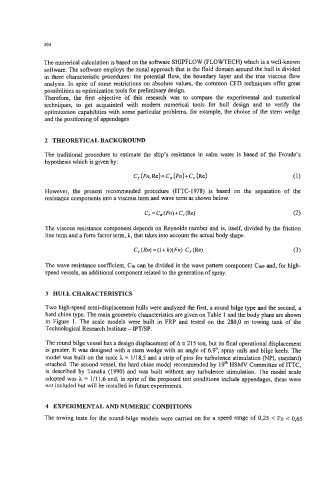Page 519 - Practical Design Ships and Floating Structures
P. 519
494
The numerical calculation is based on the software SHIPFLOW (FLOWTECH) which is a well-known
software. The software employs the zonal approach that is the fluid domain around the hull is divided
in three characteristic procedures: the potential flow, the boundary layer and the true viscous flow
analysis. In spite of some restrictions on absolute values, the common CFD techniques offer great
possibilities as optimization tools for preliminary design.
Therefore, the first objective of this research was to compare the experimental and numerical
techniques, to get acquainted with modem numerical tools for hull design and to verify the
optimization capabilities with some particular problems, for example, the choice of the stem wedge
and the positioning of appendages
2 THEORETICAL BACKGROUND
The traditional procedure to estimate the ship’s resistance in calm water is based of the Froude’s
hypothesis which is given by:
C, (Fn, Re)= C, (Fn)+ C, (Re) (1)
However, the present recommended procedure (ITTC-1978) is based on the separation of the
resistance components into a viscous term and wave term as shown below.
+
C, = C, (Fn) C, (Re) 0)
The viscous resistance component depends on Reynolds number and is, itself, divided by the friction
line term and a form factor term, k, that takes into account the actual body shape.
C, (Rn) = (1 + R)(Fn). C, (Re) (3)
The wave resistance coefficient, CW can be divided in the wave pattern component Cwp and, for high-
speed vessels, an additional component related to the generation of spray.
3 HULL CHARACTERISTICS
Two high-speed semi-displacement hulls were analyzed the first, a round bilge type and the second, a
hard chine type. The main geometric characteristics are given on Table 1 and the body plans are shown
in Figure 1. The scale models were built in FRP and tested on the 280,O m towing tank of the
Technological Research Institute - IPT/SP.
The round bilge vessel has a design displacement of A 3 2 15 ton, but its final operational displacement
is greater. It was designed with a stem wedge with an angle of 6.9’, spray rails and bilge keels. The
model was built on the scale h = 111 8,5 and a strip of pins for turbulence stimulation (NPL standard)
attached. The second vessel, the hard chine model recommended by 19* HSMV Committee of ITTC,
is described by Tanaka (1 990) and was built without any turbulence stimulation. The model scale
adopted was h = 111 1,6 and, in spite of the proposed test conditions include appendages, these were
not included but will be installed in fbture experiments.
4 EXPERIMENTAL AND NUMERIC CONDITIONS
The towing tests for the round-bilge models were carried on for a speed range of 0,25 < Fn < 0,65

